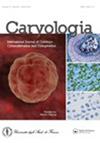泰国中国Spilopelia chinensis (Scopoli, 1786)和ruficollis Tachybaptus (Pallas, 1764)的一些分子细胞遗传学标记和经典染色体特征
IF 2.1
4区 生物学
Q2 Agricultural and Biological Sciences
引用次数: 0
摘要
本研究分析了泰国东北部两种鸟类——中国Spilopelia chinensis和ruficollis Tachybaptus的核学特征。利用成纤维细胞培养间接制备有丝分裂染色体。采用常规吉氏染色法和微卫星重复荧光原位杂交技术对染色体进行染色。吉氏染色结果显示,中国沙棘二倍体染色体数为2n=70,瑞虫二倍体染色体数为60。中国沙棘的染色体类型为4条大稳中心、2条中远中心、2条小稳中心、2条小亚稳中心、2条性染色体和58条微染色体;柽柽树核型包括2条大稳中心、2条大亚稳中心、2条大外中心、8条小稳中心、4条小亚稳中心、ZW性染色体和40条微染色体。仅在雄性红唇t染色体上表现出的分子细胞遗传学特征包括两个微卫星和端粒序列:两个微染色体上的两个d(CA)15信号,第一对染色体上的一个d(GC)15信号,以及所有宏、微染色体的每个端粒区域上的AGGGTTn序列信号。核型公式推导为:中国沙参2n (70) = Lm4 + Ma2 + Sm2 + Ssm2 + 2条性染色体(Sm1/Ssm1) + 58条微染色体,红唇沙参2n (60) = Lm2 +Lsm2 + La2 + Sm8 + Ssm4 + Z (Msm1) W (Ssm1) + 40条微染色体。本文章由计算机程序翻译,如有差异,请以英文原文为准。
Some molecular cytogenetic markers and classical chromosomal features of Spilopelia chinensis (Scopoli, 1786) and Tachybaptus ruficollis (Pallas, 1764) in Thailand
This study analyzed the karyological features of two bird species – Spilopelia chinensis and Tachybaptus ruficollis – from Northeastern Thailand. Mitotic chromosomes were indirectly prepared by fibroblast cell culture. The chromosomes were stained by conventional Giemsa staining and microsatellite repeat of fluorescence in situ hybridization techniques. Giemsa staining showed that the diploid chromosome number of S. chinensis was 2n=70 and T. ruficollis was 60. The types of chromosomes observed in S. chinensis were 4 large metacentric, 2 medium acrocentric, 2 small metacentric, 2 small submetacentric, 2 sex chromosomes and 58 microchromosomes; the karyotype of T. ruficollis comprised 2 large metacentric, 2 large submetacentric, 2 large acrocentric, 8 small metacentric, 4 small submetacentric, ZW sex chromosomes and 40 microchromosomes. The molecular cytogenetical features that were exhibited only on the male T. ruficollis chromosome included two microsatellites and telomeric sequences: two signals of d(CA)15 on two microchromosomes, one signal of d(GC)15 on one of the first pair, and signals of AGGGTTn sequences on each telomeric region of all macro- and microchromosomes. The karyotype formula was deduced as: 2n (70) = Lm4 + Ma2 + Sm2 + Ssm2 + 2 sex chromosomes (Sm1/Ssm1) + 58 microchromosomes for S. chinensis and 2n (60) = Lm2 +Lsm2 + La2 + Sm8 + Ssm4 + Z (Msm1) W (Ssm1) + 40 microchromosomes for T. ruficollis.
求助全文
通过发布文献求助,成功后即可免费获取论文全文。
去求助
来源期刊

Caryologia
生物-遗传学
CiteScore
1.60
自引率
23.80%
发文量
26
审稿时长
12 months
期刊介绍:
Caryologia is devoted to the publication of original papers, and occasionally of reviews, about plant, animal and human karyological, cytological, cytogenetic, embryological and ultrastructural studies. Articles about the structure, the organization and the biological events relating to DNA and chromatin organization in eukaryotic cells are considered. Caryologia has a strong tradition in plant and animal cytosystematics and in cytotoxicology. Bioinformatics articles may be considered, but only if they have an emphasis on the relationship between the nucleus and cytoplasm and/or the structural organization of the eukaryotic cell.
 求助内容:
求助内容: 应助结果提醒方式:
应助结果提醒方式:


